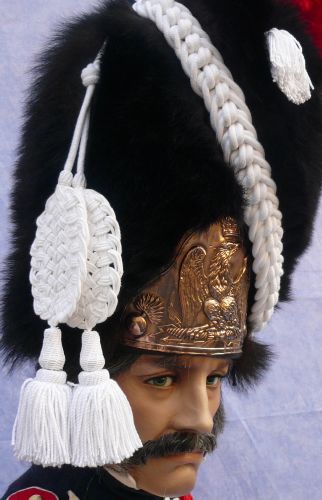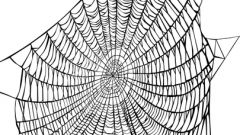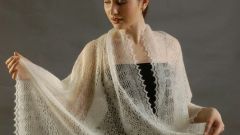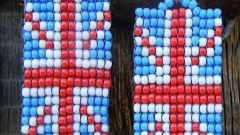You will need
- And therefore you may need: a variety of materials. Whether it's a simple thread, leather, ordinary rope. As a tool you can pick up knitting needles, hook, own hands or a special device, called thighs.
Instruction
1
Weaving five strands.
You need to take five strands, folded them in half and to something to attach. The left hand should be palm up. Threads need to hook on the little finger, middle and ring fingers, so as to form a loop.On the right hand to do the same, only the hinges need to hook on the index and middle fingers. The index finger of the right hand should catch the loop with a finger while you need to push it through the loop of the left hand. Now, on the left hand were two loops, but the right has turned three.The loop should be moved to the pinky, ring and middle fingers. Now wrap the loop from the little finger need to be repeated, only with the left hand. That is, the index finger of the left hand need to draw through the two loops and pull them through the loop from the little finger Loops to regroup so that they occupied the original position.
You need to take five strands, folded them in half and to something to attach. The left hand should be palm up. Threads need to hook on the little finger, middle and ring fingers, so as to form a loop.On the right hand to do the same, only the hinges need to hook on the index and middle fingers. The index finger of the right hand should catch the loop with a finger while you need to push it through the loop of the left hand. Now, on the left hand were two loops, but the right has turned three.The loop should be moved to the pinky, ring and middle fingers. Now wrap the loop from the little finger need to be repeated, only with the left hand. That is, the index finger of the left hand need to draw through the two loops and pull them through the loop from the little finger Loops to regroup so that they occupied the original position.
2
Aiguillette of the four strands.
Made from any materials of the finished product will depend on the thickness of the used yarn. You need to take two strands and fold them in the middle between them. If four threads, you can link them.Every thread should be mentally numbered or may they be different colors. For example, the first yellow, the second silver, the third blue, the fourth white. So, you Need to take the white thread and go around it yellow and silver thread. A silver thread to bend up, so that it is above the blue and white threads. Blue stripes bend to the right and pass it through the loop that formed a yellow thread. The resulting knot tighten. The newly formed ends to fold between the same.
Made from any materials of the finished product will depend on the thickness of the used yarn. You need to take two strands and fold them in the middle between them. If four threads, you can link them.Every thread should be mentally numbered or may they be different colors. For example, the first yellow, the second silver, the third blue, the fourth white. So, you Need to take the white thread and go around it yellow and silver thread. A silver thread to bend up, so that it is above the blue and white threads. Blue stripes bend to the right and pass it through the loop that formed a yellow thread. The resulting knot tighten. The newly formed ends to fold between the same.
3
Knitting round on needles aglet
This aiguillette is made in circular knitting method, Chulkovo binding, which is used for knitting socks, gloves. The only difference is that the number of loops. Here it should not exceed two, three pieces. Three loops need to purl alternately, and the thread should remain in the middle.
This aiguillette is made in circular knitting method, Chulkovo binding, which is used for knitting socks, gloves. The only difference is that the number of loops. Here it should not exceed two, three pieces. Three loops need to purl alternately, and the thread should remain in the middle.
4
Making aiguillette on the plug.
with a fork, it turns out square knots in the tree.
On the right side of the fork make a loop. The thread should be in front, above the loop around the left tine. Formed on the left prong loop is withdrawn back through the thread. The right tooth should circle behind and around the tooth. A loop should be removed through the free thread end of the prong. Further, the netting should continue in the same way. Threads with left and right tines are removed one by one. At the end of the weaving yarn are fixed honey.
with a fork, it turns out square knots in the tree.
On the right side of the fork make a loop. The thread should be in front, above the loop around the left tine. Formed on the left prong loop is withdrawn back through the thread. The right tooth should circle behind and around the tooth. A loop should be removed through the free thread end of the prong. Further, the netting should continue in the same way. Threads with left and right tines are removed one by one. At the end of the weaving yarn are fixed honey.
5
Celibant on the flyer
You can use two nails hammered into the basis. It would be better if the thread to weave to get thicker. Aiguillette made as follows: on the one flyer you need to wear a floating loop. Then wrap the thread around the second flyer.The thread should be routed diagonally between the flyers. Through lying working thread you need to throw first loop. The very thread we have to throw diagonally, apply the second prong, and the existing loop to transfer to the first prong. The finished aglet is removed from the flyer with a hook, knitting needles or needles. If you want the cord turned faceted, working thread does not move obliquely, and pounced right on the flyer.
You can use two nails hammered into the basis. It would be better if the thread to weave to get thicker. Aiguillette made as follows: on the one flyer you need to wear a floating loop. Then wrap the thread around the second flyer.The thread should be routed diagonally between the flyers. Through lying working thread you need to throw first loop. The very thread we have to throw diagonally, apply the second prong, and the existing loop to transfer to the first prong. The finished aglet is removed from the flyer with a hook, knitting needles or needles. If you want the cord turned faceted, working thread does not move obliquely, and pounced right on the flyer.
Note
The braided cord was attached not only to the shoulder straps and was a badge of distinction. Produced and special cords for bladed weapons, which are mounted to the handle. If the lanyard was manufactured in the form of a loop that served as a balance,and such weapons were difficult to knock out of his hands.
Useful advice
For the manufacture of the aglet is better to take a flat non-woven cords. The ends of the cord should not razluchnitsa, so it will be easier to weave the knots.




